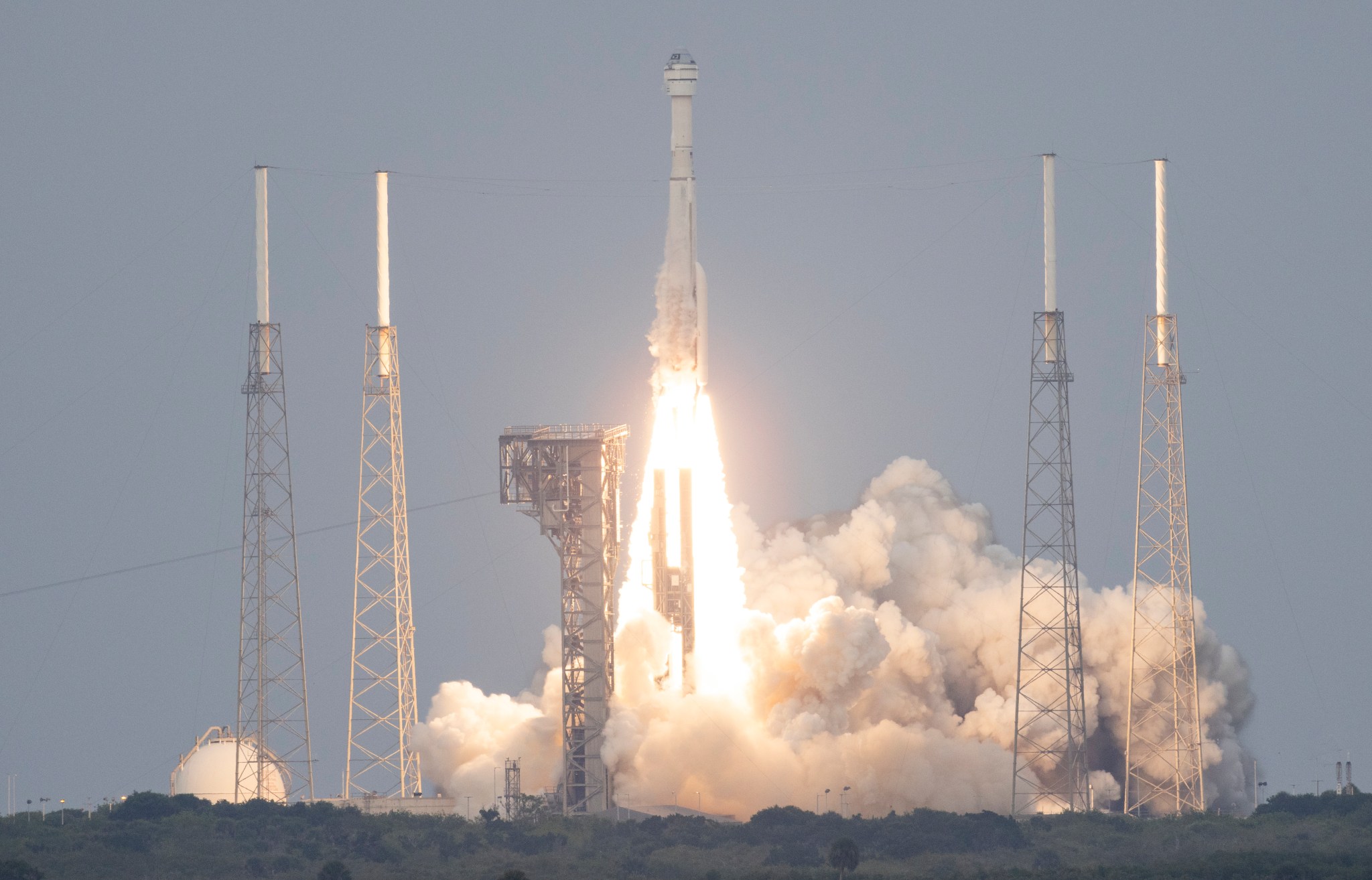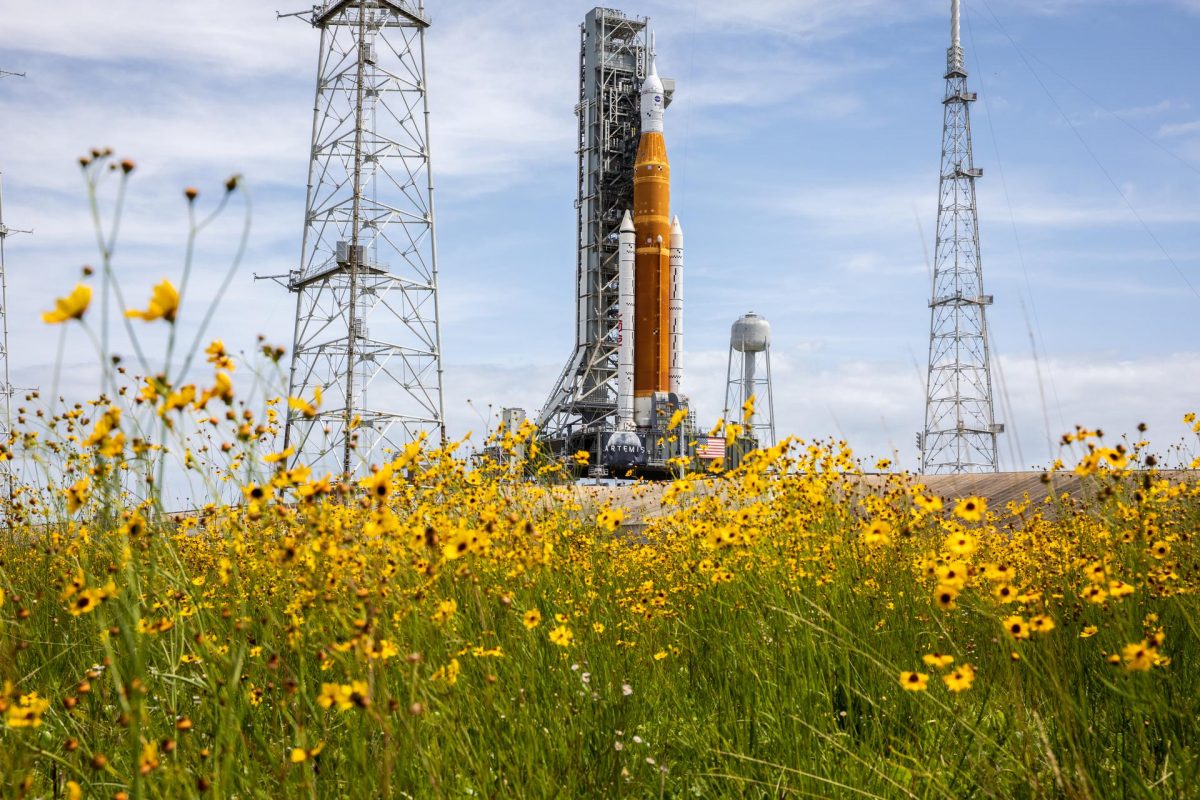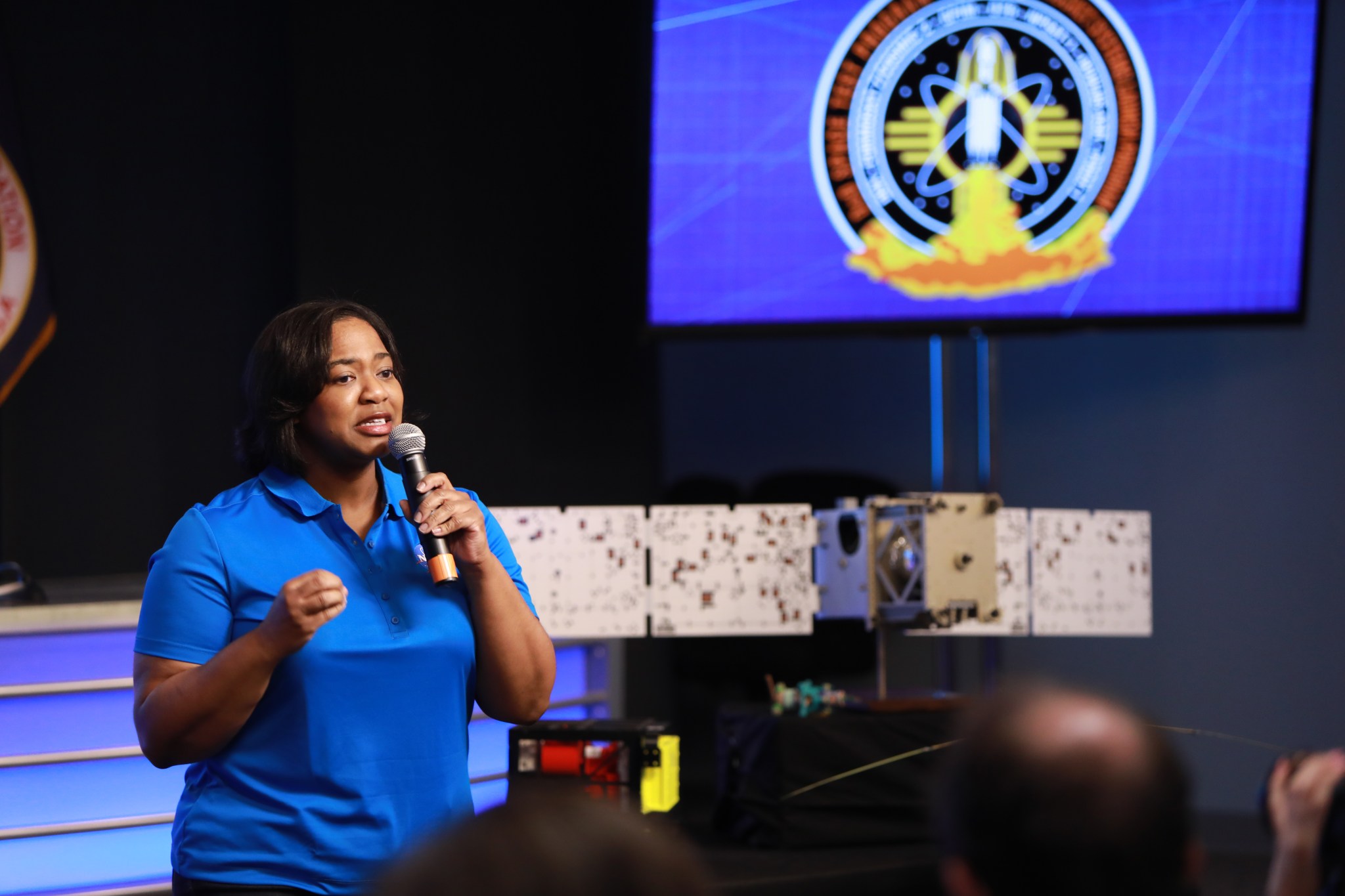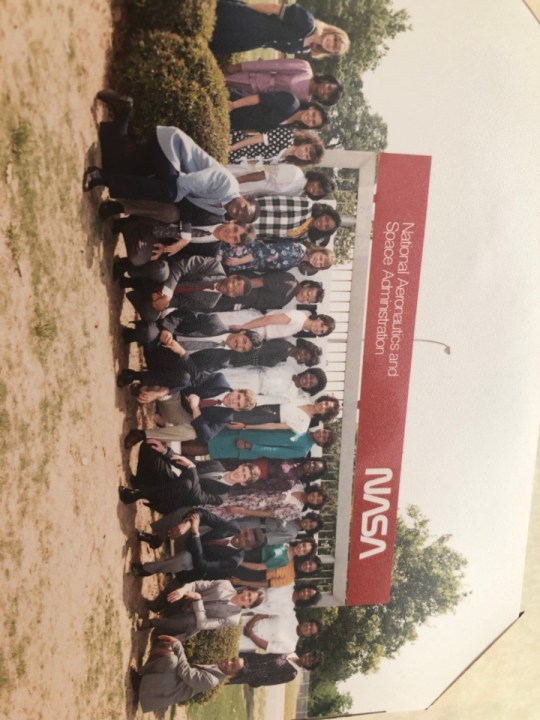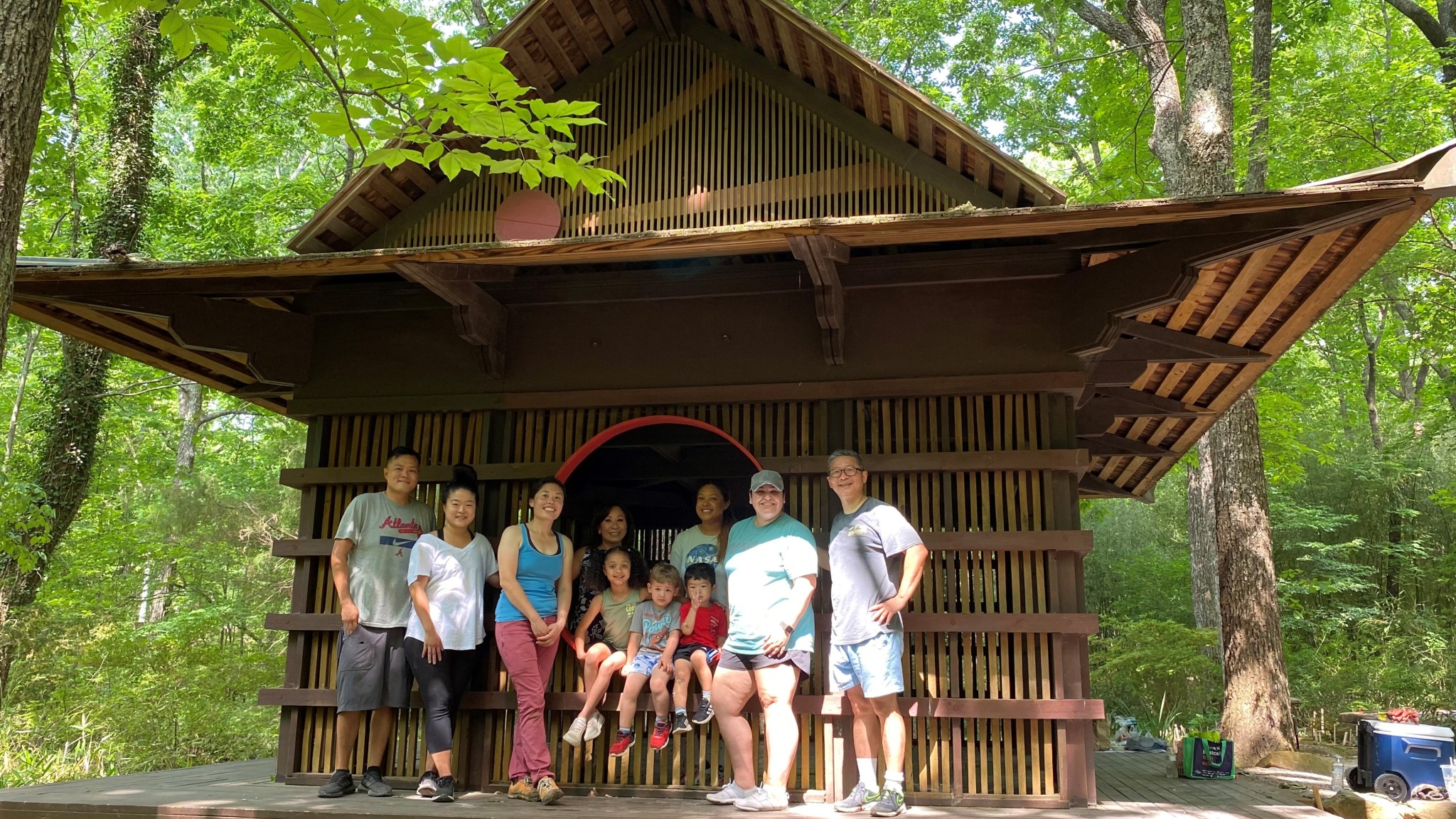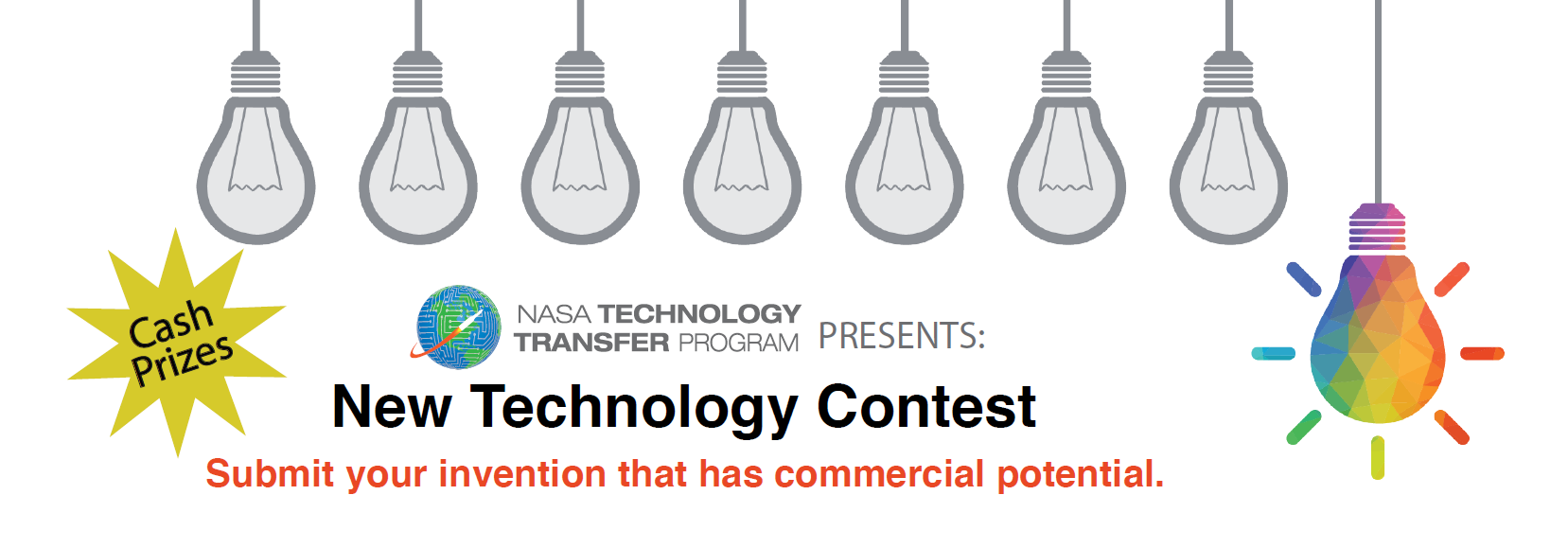Starliner Launches to Space Station with Help from Marshall Engineers
Boeing’s CST-100 Starliner launched on a United Launch Alliance Atlas V rocket to the International Space Station on May 19. The mission is designed to test the end-to-end capabilities of the crew-capable system as part of NASA’s Commercial Crew Program.
Starliner lifted off on NASA’s Boeing Orbital Flight Test-2 (OFT-2) at 5:54 p.m. CDT from Space Launch Complex-41 at Cape Canaveral Space Force Station in Florida. Following an orbital insertion burn 31 minutes later, Starliner was on its way for a rendezvous and docking with the space station.
“I am so proud of the NASA, Boeing, and United Launch Alliance teams who have worked so hard to see Starliner on its way to the International Space Station,” NASA Administrator Bill Nelson said. “Through adversity, our teams have continued to innovate for the benefit of our nation and all of humanity. I look forward to a successful end-to-end test of the Starliner spacecraft, which will help enable missions with astronauts aboard.”
Launch and orbital insertion are major milestones for the company’s second uncrewed flight, bringing the U.S. closer to having two independent crew systems flying missions to and from the space station.
“I am incredibly grateful to our NASA, Boeing, and United Launch Alliance teams that have demonstrated persistence, resolve, and dedication to ensuring we were ready for launch today and for this flight test,” said Kathryn Lueders, NASA associate administrator for space operations at NASA Headquarters. “We have learned so much as we’ve worked together to prepare for this mission.”
For the flight test, Starliner carried about 500 pounds of NASA cargo and crew supplies and more than 300 pounds of Boeing cargo to the station. Following certification, NASA missions aboard Starliner will carry up to four crew members to the station, enabling the continued expansion of the crew and increasing the amount of science and research that can be performed aboard the orbiting laboratory.
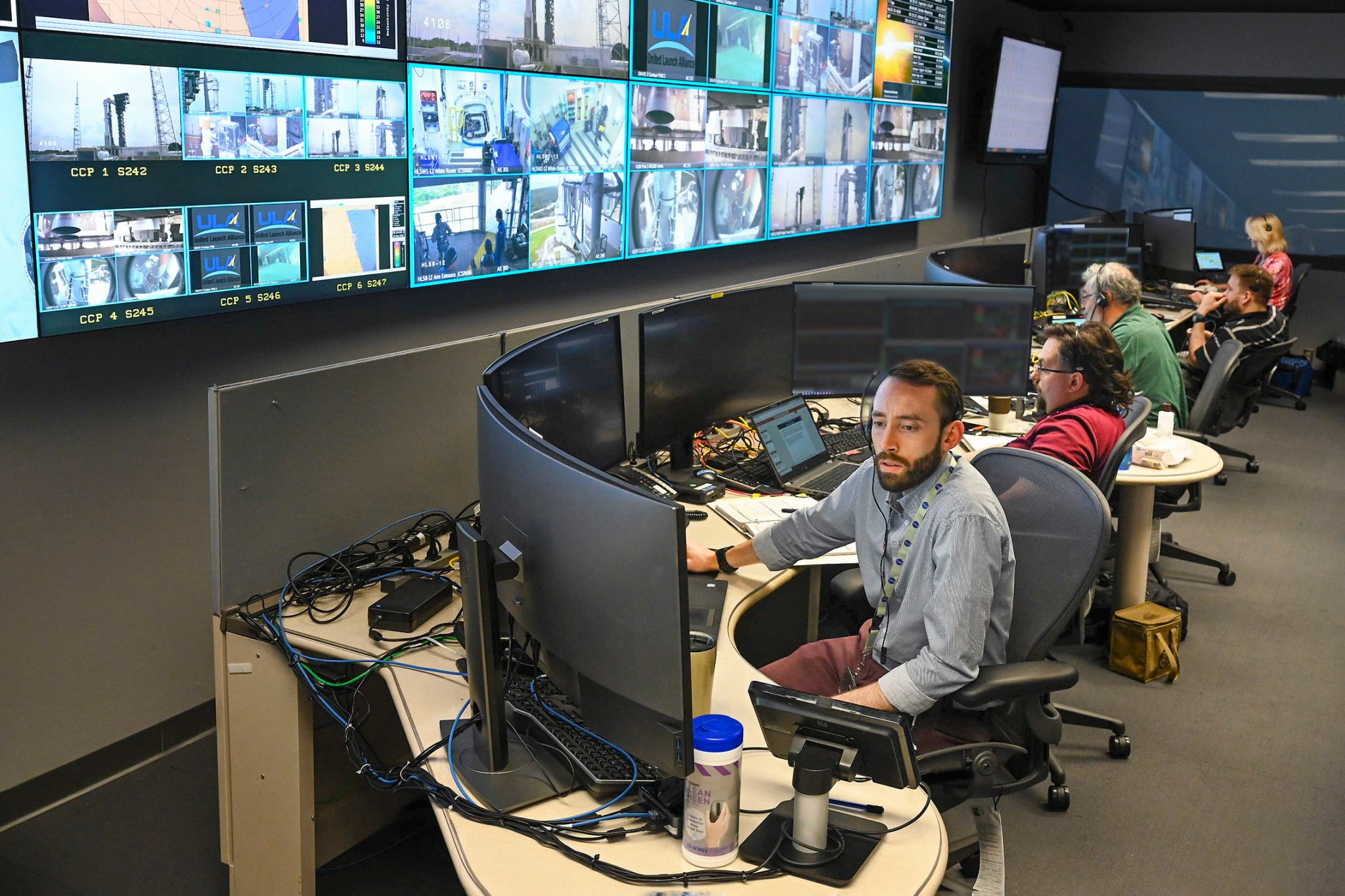
OFT-2 will provide valuable data toward NASA certifying Boeing’s crew transportation system for regular flights with astronauts to and from the space station.
“We’ve learned a lot about the capability of our spacecraft and the resilience of our team since the first Starliner launch,” said Mark Nappi, vice president and program manager, Boeing Commercial Crew Program. “We’re ready to demonstrate the system we’ve worked so hard on is capable of carrying astronauts to space.”
ULA controlled the launch of the Atlas V rocket from its Atlas Spaceflight Operations Center in Cape Canaveral. As Starliner ascended into space, Boeing commanded the spacecraft from its mission control center at NASA’s Kennedy Space Center. Boeing and ULA teams also provided support to controllers from Kennedy and Colorado, respectively, throughout the countdown to launch.
“We are proud of our partnership role with Boeing in NASA’s Commercial Crew Program and want to thank our mission partners as this is truly a collective accomplishment,” said Tory Bruno, president, and CEO of United Launch Alliance. “The successful launch today marks the first critical step toward the future of humans spaceflight onboard an Atlas V and we look forward to the remainder of the mission and to safely flying astronauts in the future.”
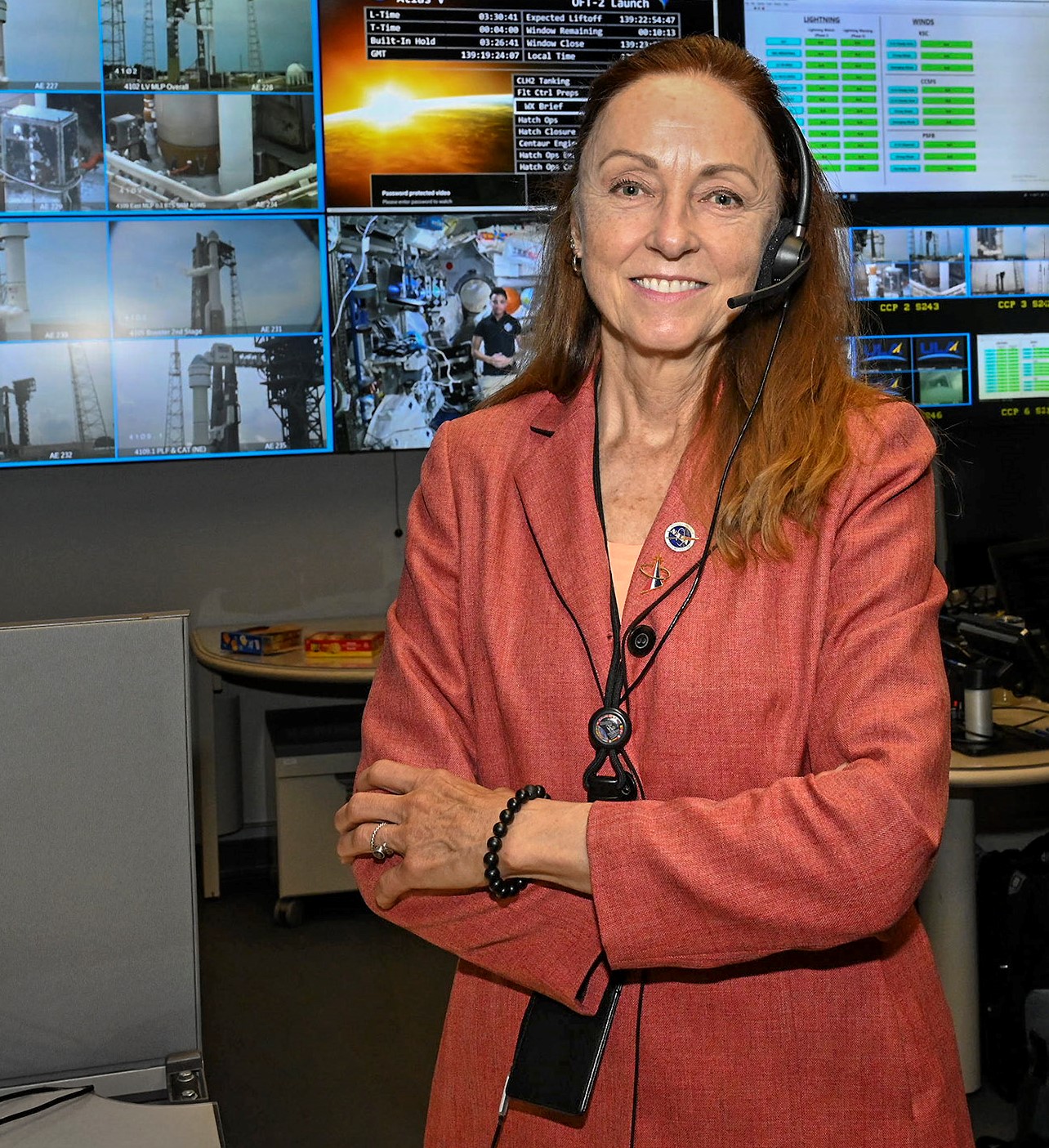
NASA’s Commercial Crew Program launch vehicle on-console mission support team in the Huntsville Operations Support Center at NASA’s Marshall Space Flight Center monitored the health of the rocket during countdown for the launch of OFT-2. The support team is split across Marshall and Kennedy. These team members play a vital role to launch operations as they assess any issues that arise during the count, reporting their recommendations to the Commercial Crew Program’s chief engineer.
“We have an incredible team with an array of engineering expertise,” said Deborah Crane, Commercial Crew Program launch vehicle chief engineer at Marshall’s Human Exploration Development & Operations Chief Engineers Office. “Each engineer reviews the data for their system in real-time where prompt and efficient communication of any anomalous system performance is paramount during the hours in the launch countdown and as the vehicle ascends from the launch pad.
“I am proud and excited to be part of this team, and the Commercial Crew Program, as we continue to work together with United Launch Alliance and Boeing to launch crew in the near future!”
Starliner is scheduled to depart the space station May 25, when it will undock and return to Earth, with a desert landing in the western U.S. The spacecraft will return with more than 600 pounds of cargo, including Nitrogen Oxygen Recharge System reusable tanks that provide breathable air to station crew members. The tanks will be refurbished on Earth and sent back to station on a future flight.
Artemis I Moon Rocket to Return to Launch Pad 39B in Early June
The Space Launch System (SLS) rocket and Orion spacecraft for the uncrewed Artemis I lunar mission are slated to return to Launch Pad 39B at NASA’s Kennedy Space Center in early June for the next wet dress rehearsal attempt.
Engineers successfully completed work on a number of items observed during the previous wet dress rehearsal test. This includes addressing the liquid hydrogen system leak at the tail service mast umbilical, replacing the interim cryogenic propulsion stage (ICPS) gaseous helium system check valve and support hardware and modifying the ICPS umbilical purge boots. The purge boots are not flight hardware but enclose an area around the ICPS umbilical – the connection between the mobile launcher and the upper stage – to protect it from the natural environment during propellant loading.
The team also confirmed there are no impacts to Orion as a result of storms and subsequent water intrusion at the launch pad. The team updated software to address issues encountered during core stage tanking of liquid hydrogen and liquid oxygen during previous rehearsal attempts. The updates are based on what the team learned and will improve the propellant loading process for the upcoming wet dress rehearsal.
Meanwhile the Kennedy contractor for gaseous nitrogen has completed their repairs to the distribution system that will be used to support the Artemis testing and launch campaign. The repairs and tests ensured the system is ready to support tanking operations. During wet dress rehearsal and launch, teams use gaseous nitrogen to purge the rocket including its umbilical plates and to support other operations.
Engineers also are completing some of the forward work originally scheduled to take place in the Vehicle Assembly Building after wet dress rehearsal. This includes opening the Orion crew module hatch and installing some payloads, such as hardware elements for the Callisto technology demonstration, a flight kit locker, and container assemblies for a space biology experiment.
Following completion of a few remaining verifications, teams will retract platforms inside the Vehicle Assembly Building to prepare SLS and Orion to roll out to pad 39B. Plans call for the next wet dress rehearsal to take place about 14 days after the rocket arrives at the pad.
Take 5 with Tawnya Plummer Laughinghouse
By Daniel Boyette
Instead of pursuing her dreams of becoming a doctor, Tawnya Plummer Laughinghouse decided to follow a new career path – after completing a NASA apprenticeship – that would eventually lead her to space technology.
Laughinghouse is manager for Technology Demonstration Missions at NASA’s Marshall Space Flight Center, where she oversees the largest program in the agency’s Space Technology Mission Directorate. But during middle school and most of high school, Laughinghouse had her heart set on being an OB-GYN, and she was selected for early admission to medical school at the University of Alabama at Birmingham.
Those plans changed in 1990 when she was selected to be part of NASA’s Summer High School Apprenticeship Research Program to work for six weeks with scientists and engineers in the former Space Science Laboratory at Marshall. That summer, Laughinghouse learned about the Women in Science and Engineering program, a partnership between NASA and Spelman College in Atlanta that encouraged underrepresented groups of women to pursue careers in science, technology, engineering, and math. She was selected and went on to complete a dual-degree program, earning a bachelor’s degree in chemistry from Spelman and a bachelor’s in chemical engineering from Georgia Tech.
After graduation, Laughinghouse worked in chemical manufacturing industries for several years. She joined Marshall in 2004.
“It’s been a thrill for the last 18 years,” she said.
Question: What are your primary responsibilities as manager for Technology Demonstration Missions?
Laughinghouse: My responsibilities are twofold. First, I manage and execute a portfolio of technology demonstration ground and flight projects led by NASA centers and industry partners across the country. We mature them to system-level demonstrations in space or space-like environments on the ground. As manager for the Technology Demonstration Missions Program Office – part of the Science and Technology Office at Marshall – I lead a truly stellar team of senior-level folks, including mission managers, program planning and control personnel, independent tech authority, and procurement/acquisition specialists. These team members ensure we provide guidance and direction to our projects through their respective development life cycles, and the right level of insight to our numerous stakeholders, administratively through the center, and programmatically to the Space Technology Mission Directorate.
Question: What excites you most about the future of space technology and exploration?
Laughinghouse: With a mantra of “Technology Drives Exploration,” the Space Technology Mission Directorate’s mission is to drive innovation and advanced technology throughout the agency while opening greater opportunity for partnerships with industry, academia, and small businesses. Since I became program manager in late 2018, Technology Demonstration Missions has launched six technologies to space as rideshares/hosted payloads on commercial rockets or as part of Department of Defense missions. So, it gives me tremendous satisfaction knowing I have a hand in making sure we have the cutting-edge in innovative technology that enables rewarding new space missions – missions that ultimately advance exploration and our understanding of the solar system and the universe around us.
Technology Demonstration Missions has two exciting launches scheduled for this fall: the Low Earth Orbit Flight Test of an Inflatable Decelerator, which will demonstrate a crosscutting aeroshell – a type of heat shield – for atmospheric reentry; and Deep Space Optical Communications, the agency’s first demonstration of optical communications beyond the Earth-Moon system.
Question: You’ve said that one of the reasons you want to excel is to help pave the way for “the next Tawnya” to get an opportunity. Would you speak more on the importance of leaving a legacy?
Laughinghouse: While there’s nothing wrong with aspiring to be the first this or that throughout your career, I believe your impact is so much greater when you are intentional about preparing others for the opportunities that will ensure you’re not the last. I count it an honor when a fellow supervisor asks if I can mentor a new leader in their department or a performer with high potential. I made a personal commitment to start engaging with mentoring sessions almost every week since the summer of 2020 and have participated in dozens of mostly virtual outreach events, sharing my work/career at NASA, thoughts on leadership, and providing encouragement to students locally, nationally, and even internationally.
Question: What has been the proudest moment of your NASA career?
Laughinghouse: In 2019, I was honored to be part of a contingent of Marshall female engineers and leaders, including Marshall Director Jody Singer, to represent “Ladies Who Launch” on the “Today” show for International Women’s Day. One of the ladies in our group, the late Roslin Hicks, was one of the young Marshall engineers who first inspired me as an intern. That was an amazing opportunity for all of us to represent the diversity of NASA and to impress upon young minds and space enthusiasts they are only limited by their imagination. During any special moment of my career, it means everything to me when my family – which includes my husband and teenaged daughter and son – have a chance to experience it. That is why sharing my proudest moment with my daughter, who was 12 at the time, was the most incredible part of that day.
Question: What advice would you give to NASA young professionals or those considering a career with the agency?
Laughinghouse: Keep yourself open to new opportunities for growth, even if they aren’t in your natural or trained/technical skill set. Having depth and breadth of experience makes you even more valuable to your organization or team.
Pursue leadership development programs – like NASA’s Foundations of Influence, Relationships, Success, and Teamwork, or the Army Aviation and Missile Command’s Leader Investment for Tomorrow – designed for early careers. I found those programs to be an excellent way to jump-start strong connections and relationships across the agency, and I applied the concepts and tools I developed for increasingly higher responsibility assignments.
Make sure your mentors reflect a wide range of experiences and perspectives.
Do what makes you uncomfortable. You won’t have all the answers as you start something new and that’s OK. You’ll grow as you learn, so be sure to enjoy the journey.
Boyette, an LSINC employee, supports Marshall’s Office of Strategic Analysis & Communications.
Webb Telescope Director Gregory Robinson Stresses Importance of Maintaining Resiliency
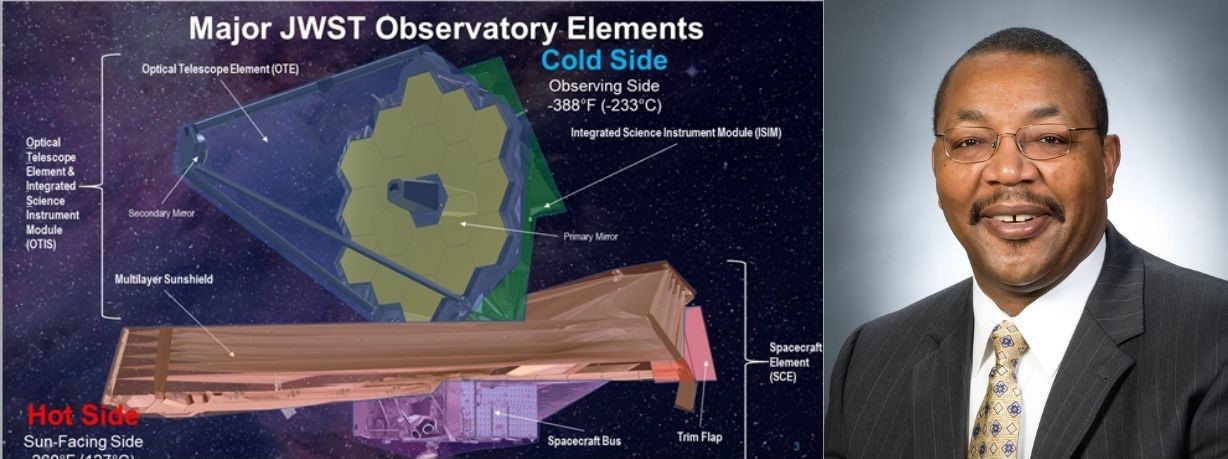
Gregory Robinson, director for NASA’s James Webb Space Telescope Program, discussed the Webb mission May 19 as part of Marshall Space Flight Center’s Mission Success is in Our Hands virtual lecture series. In “Increasing the Performance of Complex Systems Development,” Robinson shared the challenges faced and feats accomplished in successfully developing and launching the telescope into orbit. Marshall contributed to the development of Webb, which launched Christmas Day 2021. Webb is the most complex telescope ever built and will serve as the premier space observatory of the next decade, studying every phase in the history of the universe. Robinson said Webb is NASA’s highest priority science mission, with 29 states and 14 countries contributing toward its development. He discussed the complexity of reviewing and inspecting 348 potential points of failure on the observatory. Robinson said large missions such as Webb take a long time to develop, and resiliency is required. “It’s extremely complex doing things that have never been done before and the mission itself is quite challenging,” Robinson said. “We have a few setbacks, but we generally recover. So, the folks working Artemis, SLS, Orion, and some of those missions, don’t despair just yet. It takes a while for us to get there.” A former deputy associate administrator for programs for NASA’s Science Mission Directorate, Robinson was responsible for the operations of 114 science flight projects and engaged with 21 space shuttle launches. The goal of Mission Success is in Our Hands is to help team members make meaningful connections between their jobs and the safety and success of NASA and Marshall missions through shared experiences discussions, awards, and recognition. To watch a recording of the presentation, visit here. (NASA)
Jill Brown Receives Golden Eagle Award
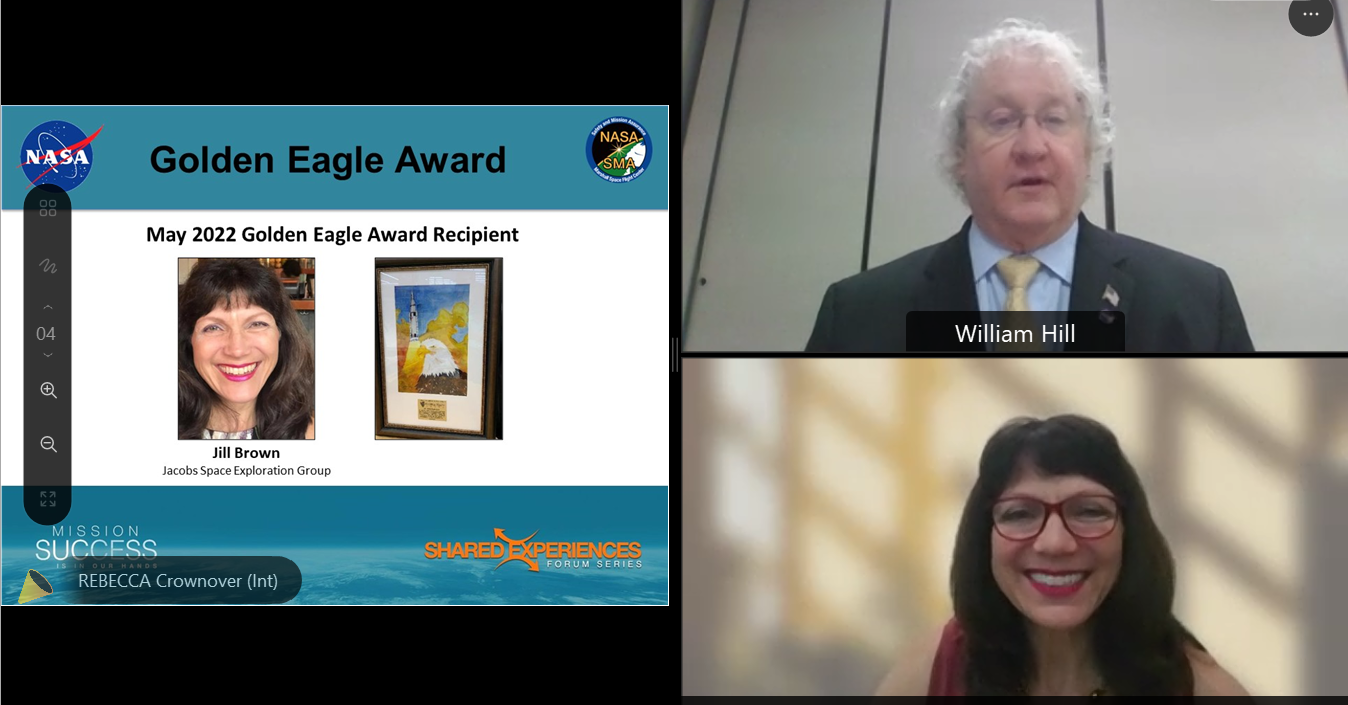
Bill Hill, top right, director of the Safety and Mission Assurance Directorate at NASA’s Marshall Space Flight Center, presents Jill Brown of Jacobs Space Exploration Group with the Golden Eagle Award during the Mission Success is in Our Hands virtual lecture series May 19. The award is presented to team members who make significant, identifiable contributions to flight safety and mission success. (NASA)
NASA’s Asian American Employee Resource Group Plants Seeds for Better, More Inclusive Future
By Rick Smith
Team members from NASA’s Marshall Space Flight Center spent a balmy Saturday in late May sweating for a good cause. They volunteered their time to help plant new greenery and clean up the site of the North Alabama Japanese Garden, an idyllic spot on Monte Sano Mountain known for its traditional tea house, which is home to popular spring and autumn Japanese tea festivals.
Teamwork, community, and public service were the order of the day for the volunteers – all members of the Marshall Asian American/Pacific Islander Employee Resource Group. Their contributions honored Asian American and Native Hawaiian/Pacific Islander Heritage Month, which concludes May 31.
Such work has other benefits, said group co-chair Lien Moore, lead system engineer for integrated avionics and software on NASA’s Human Landing System Program.
“Our goal is to promote awareness, to educate people about the variety of different cultures represented among our diverse group, and to help foster a greater sense of community – among Marshall’s Asian American team members and as a valued, integral part of the larger NASA family,” Moore said.
Those goals actively support the NASA Equity Plan, which strives to anchor diversity and equity as a core component of every NASA mission and to identify and remove career barriers that hinder historically underserved and underrepresented communities.
Moore knows how crucial those opportunities can be, having fled her homeland as a child with her family during the Vietnam War. “As immigrant refugees, we learned to adapt and survive – but each of us has the potential to be so much more. We all have something to contribute, and we all deserve to belong,” she said.
The Marshall resource group is open to any Marshall civil service employee or contractor – not just those of Asian American, Native Hawaiian, or Pacific Islander heritage. Moore and fellow co-chair Tony Kim, SERVIR project manager at Marshall, currently are working to provide the group a landing page on Marshall’s intranet for relevant news, activities, and useful resources.
The organization holds a virtual meeting every other week to discuss relevant issues. Its members assist with intern and new employee orientation, introduce new hires to the Huntsville area, and provide other services to help promote career placement and advancement – including helping newcomers learn the nuances of American workplace etiquette, some of which differ dramatically from those in many Eastern cultures.
“Community, strong working relationships, trust, and personal connections have always been Marshall’s chief strengths,” Moore said. “We strive to build on those principles, and to help our members demonstrate their value to Marshall leadership and to the programs and missions we support.”
Working closely with Moore and Kim is Nina Creel, equal employment opportunity specialist and special emphasis program manager in Marshall’s Office of Diversity & Equal Opportunity. The trio also meets virtually once a month with key employee resource group chairs at other NASA centers around the country – ensuring new ideas and lessons learned are widely shared to benefit the agency as a whole.
The value of that cross-center commitment is self-evident. “When enthusiastic, talented people come together, fully committed to a mission with a clear goal and a significant benefit to our society and the world, there’s no end to what they can achieve,” Moore said. “NASA demonstrates that every day. And contributors of Asian/Pacific heritage are vital to that effort.”
As the annual heritage month concludes, Moore said, the Marshall resource group is committed to sustaining its influence year-round – and looking to the future.
“A wise man named Nelson Henderson once said that the true meaning of life is to plant trees under whose shade you do not expect to sit,” she said. “We instill community in our membership for the same reasons we plant seeds in the garden – so that long after we’re gone, generations still to come will be warmly welcomed into the same rewarding team environment that we enjoy and work together to sustain.”
Marshall supports a variety of employee resource groups. Team members also are encouraged to check out the monthly “Talk Equity, Diversity, & Inclusion” newsletter on Inside Marshall.
Smith, a Manufacturing Technical Solutions employee, supports Marshall’s Office of Strategic Analysis & Communications.
New Technology Contest Returns with More Cash Awards
By Lance D. Davis
NASA’s Technology Transfer Program recently launched the 2022 New Technology Report contest. Awards totaling $10,000 will be given to civil servants whose new technology reports have the most commercial potential.
Civil servants should enter their submissions here no later than July 8 to be considered for the following cash awards:
- First place: $3,000
- Second place: $2,500
- Third place: $2,000
- Fourth place: $1,500
- Fifth place: $1,000
New Technology Reports are the first step in helping NASA make the most of inventors’ technology and will be judged on their commercialization capability in areas like automotive, manufacturing, sensors, materials and coatings, health, medicine, and more.
“Our goal is to increase the number of commercially viable New Technology Reports from our Marshall community,” said Sammy Nabors, manager of Marshall’s Technology Transfer Branch.
Marshall civil service employees can submit multiple reports, either individually or as a group. The cash prizes will be awarded to inventors, with group entries splitting the award evenly.
“We hope the contest encourages more submissions from established Marshall inventors and inspires first-time inventors to engage in the Technology Transfer process,” Nabors said. “Last year the contest was very successful, and we hope to have even more participation in 2022.”
If you have additional questions or need assistance, contact Kyle Costabile, senior licensing executive with Acuity Edge, and patent portfolio manager in Marshall’s Tech Transfer Branch.
Learn more about the New Technology Contest on Inside Marshall. Also, read about the 2021 contest winners here.
Davis is a public affairs officer in Marshall’s Office of Strategic Analysis & Communications.
NASA History: First Juno Science Results
Five years ago this week, on May 25, 2017, NASA released the first science results from the Juno mission’s observations of Jupiter, the largest planet in the solar system. Juno launched Aug. 5, 2011, and entered Jupiter’s orbit July 4, 2016. It revealed the planet to be a “complex, gigantic, turbulent world.” One of the most astounding returns was the discovery of densely clustered, Earth-sized swirling storms at both of Jupiter’s poles. Another important discovery was that Jupiter’s magnetic field proved even stronger than models predicted and was more irregular in shape. Results from Juno’s magnetometer investigation proved a magnetic field about 10 times stronger than the strongest magnetic field found on Earth. Juno is managed by NASA’s Jet Propulsion Laboratory. The mission is part of the New Frontiers Program, which is managed by NASA’s Marshall Space Flight Center. For more information on NASA history, visit here. (NASA)


























